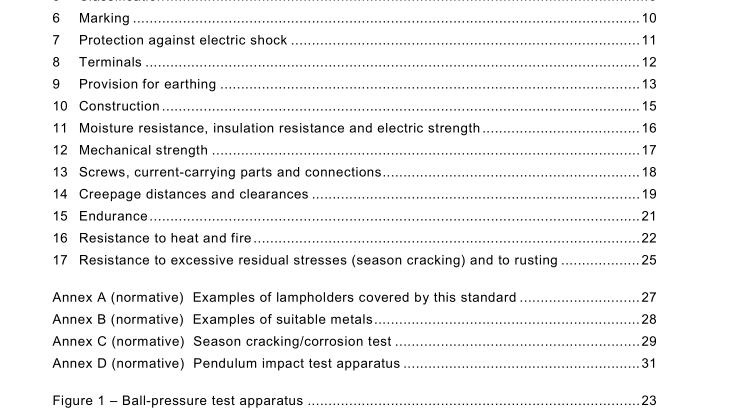IEC 60838-1:2008 pdf download – Miscellaneous lampholders – Part 1: General requirements and tests
For cross-section of conductors: the relevant value or values in the case of a range, in square millimetres (mm 2 ), shall be followed by a small square (e.g. 0,5 ). Compliance is checked by inspection. For lampholders according to this standard, the distances for impulse withstand category II are usually applicable. For holders in equipment where a higher degree of availability is expected, distances for impulse withstand category III may be applicable. This information has to be indicated in the manufacturer’s catalogue or the like. Lampholders complying with the electrical strength test for double or reinforced insulation and having creepage distances and clearances equivalent to double or reinforced insulation offer an adequate level of protection for the use in luminaries where they are accessible in normal use. Such lampholders are addressed as lampholders for use in class II applications. This information shall be indicated in the manufacturer’s catalogue or the like.
NOTE 3 Values for creepage distances and clearances as well as test voltages for the electrical strength test for double or reinforced insulation are given in IEC 60598-1 .
To achieve sufficient creepage distances and clearances to outer accessible surfaces, additional attachments could be used. In some cases, these dimensions might be achieved only after mounting the lampholder in the luminaire. Relevant information should be provided in the manufacturer’s catalogue or the like.
6.3 The instructions supplied by the holder manufacturer or responsible vendor shall contain all the information required to ensure correct mounting and operation of the connectors or holders.
NOTE The information may be part of the manufacturer’s or responsible vendor’s catalogue. Compliance is checked by inspection.
6.4 Marking shall be durable and easily legible. Compliance is checked by inspection and by trying to remove the marking by rubbing lightly for 15 s with a piece of cloth soaked with water and for a further 15 s with a piece of cloth soaked with petroleum spirit. After the test the marking shall still be legible.
NOTE The petroleum spirit used should consist of a solvent hexane with a content of aromatics of maximum 0,1 volume percentage, a kauri-butanol value of 29, an initial boiling point of approximately 65 °C, a dry-point of approximately 69 °C and a specific density of approximately 0,68 g/cm 3 .
7 Protection against electric shock
7.1 Enclosed lampholders shall be so constructed that, when the holder has been built in or installed and wired as in normal use, their live parts are not accessible
– without a lamp inserted;
– with the appropriate lamp inserted, and
– during insertion or removal of the lamp. For lampholders which have been in use for a long time, such as B22d-3, BY22d, G22, G38, P28s, P30s and P40, the above requirement applies only with the appropriate lamp inserted. The insertion of only one pin of the lamp (in case of caps with more than one pin) to the first point of contact with live parts shall be prevented.
Lampholders G22 and G38 are exempted from this requirement. Compliance is checked by means of the standard test finger specified in IEC 60529.This test finger is applied in every possible position with a force not exceeding 10 N, an electrical indicator being used to show contact with live parts. It is recommended that a voltage of not less than 40 V be used. The lampholders are mounted as in normal use, i.e. on a supporting surface or the like with the most unfavourable conductor size fitted for which it is intended before being subjected to the above test. Unenclosed lampholders are only tested after appropriate installation in a luminaire or other additional enclosure when that equipment is tested according to its own standard.
7.2 Lampholders for double-ended lamps shall be so constructed that, when the two holders have been built in or installed and wired as in normal use, their live parts are not accessible
– without a lamp inserted;
– with the appropriate lamp inserted, and
– during insertion and removal of the lamp. In case of lampholders R7s/RX7s, a test which simulates insertion or removal of the lamp is not available because in both cases testing has to be done against the spring force of the single contact. This situation does not give the repeatability required for judgement. Therefore, this test is replaced by one with the lamp inserted. Compliance is checked in accordance with IEC 60061 or unless otherwise specified in IEC 60061, with the standard test finger.
8 Terminals
8.1 Lampholders shall be provided with at least one of the following means of connection:
– screw-type terminals;
– screwless terminals;
– tabs or pins for push-on connections;
– posts for wire wrapping;
– soldering lugs;
– connecting leads (tails). Terminal screws and nuts shall have a metric ISO thread. Lampholders with screwless terminals, unless intended for sale to luminaire or equipment manufacturers, shall be provided with terminals which are equally satisfactory with both rigid (solid or stranded) conductors and flexible cables or cords. Other means of connection than those specified are permitted provided they are equal in performance to the methods listed. An example for such a means of connection is a contact of a lampholder for extra low voltage halogen lamps providing electrical connection to a metal part of the luminaire during lampholder assembly. Compliance is checked by the tests of 8.2 or 8.3 respectively.
